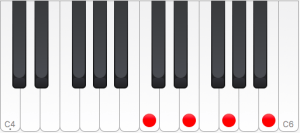Chord Scales: How To Harmonize Melodies Fast
 Would you like to learn how to figure out chord scales? Want to learn some neat tricks to fatten up your melodies?
Would you like to learn how to figure out chord scales? Want to learn some neat tricks to fatten up your melodies?
You’ve come to the right place.
In this lesson, you’ll learn a technique for fattening up your melodies.
It works on any scale over any chord. Let’s dig in.
Why You’re Having Trouble Understanding Chord Scales
 Chord scales can mean any of these concepts:
Chord scales can mean any of these concepts:
- Playing an arpeggio with all of the naturally possible extensions.
- Scale-chord matching – This means we’re trying to figure out what scales fit what chord.
- Harmonizing a scale – Playing all possible chords within a given scale. Sometimes we call these “family chords”.
Because we’re talking about three things that all mean “chord scales”, it can be confusing. Let’s go right ahead and sort this all out.
How To Practice A Scale Like A Chord
 If you’ve taken your piano lessons seriously, you would have practiced scales.
If you’ve taken your piano lessons seriously, you would have practiced scales.
Scales have always been a staple in any compilation of pianistic technical exercises.
I wouldn’t be surprised at all if you had practiced your scales like this before:
What if you can shake things up and make it more interesting? Perhaps you can try practicings scales this way instead:
In the video above, I was practicing an Eb bebop major scale using chord scales.
Chord scales in this approach are simply arpeggios that include all possible extensions.
Let’s look at our Ebmaj7 arpeggio with extensions:

What we have are the notes Eb – G – Bb – D – F – Ab – C.
By playing Ebmaj7 and adding the 9th, 11th, and 13th, you have just played the Eb major scale except in a “chordal” manner.
This now creates the impression of a chord scale.
Now try this one out:

Play all of the notes above and you have a Bb(alt) chord with all of the extensions. Play that melodically and what you get is a Bb altered scale.
This is the second chord scale according to our first definition.
Speaking of using chords scales, do you wonder how your hero uses them?
 You can learn all that and improve your vocabulary with the Jazz Masters Method.
You can learn all that and improve your vocabulary with the Jazz Masters Method.
Inside the Jazz Masters Method, you’ll discover how to navigate through the most common jazz chord progressions so you’ll never get stuck improvising over your favorite jazz tunes.
Get instant access to the Jazz Masters Method here.
Now that you understand this first definition of chord scales, let’s look at the second definition more deeply.
Why Chord-Scale Matching Brings A Lot Of Interesting Results
 The answer is really simple: The more scales you can match to a single chord, the more colors you have for improvising and melody writing.
The answer is really simple: The more scales you can match to a single chord, the more colors you have for improvising and melody writing.
You can use a total of 5 scales over any major chord, 10 scales over any minor chord, and more than 10 scales over a dominant 7th chord.
Knowing all of these choices will help you improvise using various scales.
You can learn more about these chord scale matches through the Ultimate Jazz Scales Book.
Inside this book, you’ll discover 372 scales that you can use for jazz, blues, and rock improvisation and composition.
Grab your copy of the Ultimate Jazz Scales Book here.
If you’ve read this far, I know exactly what you came here for.
Read on as I reveal the thick, meaty stuff below.
One Amazing Pattern To Harmonize Any Scale Or Melody
 It’s easy enough to randomly grab notes to form chords from any scale.
It’s easy enough to randomly grab notes to form chords from any scale.
However, this approach is a double-edged sword.
You can easily come up with really cool sounds. However, it will sound bad when used in the wrong places.
Realizing that, I came up with a technique to harmonize any melody over any chord in a simple yet hip way.
Here’s the formula that works for any seven-note scale. Let’s use our C major scale as an example:
For the 1st scale degree (C), play it as a quartal voicing with the scale note on top. So, what we have is D – G – C:

Now play the next scale note (D) on top and harmonize below with E – G – B:

Play the 3rd scale degree (E) while keeping the same three notes below (E – G – B):

For the 4th scale degree (F), play it with quartal voicings below. You chord should have G, C, and F:

Your 5th scale degree is G. Harmonize it below with A, C, and E:

Play the 6th scale degree, A, with B and E below:

For the 7th scale degree, B, play C-E-G below it:

As you can see above, you harmonize each scale note with either a quartal voicing or a triadic voicing.
Over any 7-note scale, the harmonization formula is 1- quartal, 2 – triadic, 3 – triadic, 4 – quartal, 5 – triadic, 6 – quartal, 7 – triadic.
The 1st, 4th, and 6th degrees will have quartal voicings while the 2nd, 3rd, 5th, and 7th will have triadic voicings.
Use this technique to make your melodies sound full and rich.
Why This Chord Scales Harmony Formula Makes Sounding Hip Easy
 There are 2 reasons why you can sound really hip and sophisticated with the formula you have just learned:
There are 2 reasons why you can sound really hip and sophisticated with the formula you have just learned:
- When your melody has the 1st, 4th, and 6th scale degrees, you use hip-sounding quartal voicings.
- You will instantly harmonize your melody with chord extensions, depending on the melody and inner voice notes you play.
Apply the harmonization formula to your tunes to make your melodies sound full and more interesting.
You can even try and combine this technique with Barry Harris’s 6th diminished harmony to take it up a step further.
With these new techniques, the question now is how do you go a step further and get it on stage?
How To Go From The Practice Room To The Stage
 Do you wonder why the awesome things you do never leave the practice room? Are you frustrated that you feel like you’re playing is worse on stage?
Do you wonder why the awesome things you do never leave the practice room? Are you frustrated that you feel like you’re playing is worse on stage?
You may have worked out a lot of techniques and concepts during practice time.
You think you’ve done all the work you can do, only to find out that all of it goes out the window once you step up for a live gig.
There is nothing more frustrating than all your hard work going up in smoke in a single night.
The good news is that there is a mentor that can help you. That way, you won’t need to experience such trouble again.
We can help find the perfect mentor for you inside the Jazz Inner Circle.
 The Jazz Inner Circle provides the opportunity to train with seasoned, world-class jazz piano instructors one on one. They will teach you how to play what works both on stage and in the studio.
The Jazz Inner Circle provides the opportunity to train with seasoned, world-class jazz piano instructors one on one. They will teach you how to play what works both on stage and in the studio.
Inside the Jazz Inner Circle you’ll discover:
- “The Jazz Piano Mastery Program” (Over $25,000 worth of jazz piano training resources, tools, practice templates, improv strategies, & tons more.)
- “The Ultimate Jazz Workout Training System.” This is where we implement a complete practice program to build your jazz piano talent in record time.
- Access to over 50 hours of high-level jazz intensive workshops.
- And much more.
Apply for 1 on 1 training here.
We hope that you enjoyed this lesson on chord scales. If you have questions, comments, or suggestions for a new lesson, feel free to drop a note in the comments section below.
Here’s the part where you go to your piano and start practicing and making music. Have fun.
